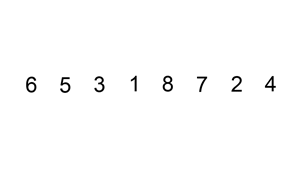14. 最长公共前缀
编写一个函数来查找字符串数组中的最长公共前缀。
如果不存在公共前缀,返回空字符串 ““。
示例 1:
输入: ["flower","flow","flight"]
输出: "fl"
示例 2:
输入: ["dog","racecar","car"]
输出: ""
解释: 输入不存在公共前缀。
说明:
所有输入只包含小写字母 a-z 。
1
2
3
4
5
6
7
8
9
10
11
12
13
14
15
16
17
18
19
20
21
22
23
24
25
26
27
28
29
char * longestCommonPrefix(char ** strs, int strsSize){
if(!strs || strsSize == 0){
return "";
}else if(strsSize == 1){
return strs[0];
}
int idx = 0;
const char *pbase = strs[0], *pcur = NULL;
while(true){
for(int i = 1; i < strsSize; i++){
pcur = strs[i];
if(!*(pbase + idx) || !*(pcur + idx) ||
*(pbase + idx) != *(pcur + idx)){
goto END;
}
}
idx++;
}
END:
if(idx == 0){
return "";
}
char * pret = (char *)malloc(sizeof(char)*idx+1);
strncpy(pret, pbase, idx);
pret[idx] = '\0';
return pret;
}
测试一下,
执行结果:
通过
显示详情
执行用时 :8 ms, 在所有 C 提交中击败了69.44% 的用户
内存消耗 :7 MB, 在所有 C 提交中击败了82.49%的用户
344. 反转字符串
编写一个函数,其作用是将输入的字符串反转过来。输入字符串以字符数组 char[] 的形式给出。 不要给另外的数组分配额外的空间,你必须原地修改输入数组、使用 O(1) 的额外空间解决这一问题。 你可以假设数组中的所有字符都是 ASCII 码表中的可打印字符。
示例 1:
输入:["h","e","l","l","o"]
输出:["o","l","l","e","h"]
示例 2:
输入:["H","a","n","n","a","h"]
输出:["h","a","n","n","a","H"]
1
2
3
4
5
6
7
8
9
10
11
12
13
14
15
16
17
void reverseString(char* s, int sSize){
if(!s || sSize <= 1){
return;
}
char *pbeg = s, *pend = s + sSize - 1;
char tmp;
while(pbeg < pend){
tmp = *pbeg;
*pbeg = *pend;
*pend = tmp;
pbeg++;
pend--;
}
return;
}
测试一下,
执行结果:
通过
显示详情
执行用时 :64 ms, 在所有 C 提交中击败了97.30% 的用户
内存消耗 :13.7 MB, 在所有 C 提交中击败了75.23%的用户
415. 字符串相加
给定两个字符串形式的非负整数 num1 和num2 ,计算它们的和。
注意: num1 和num2 的长度都小于 5100. num1 和num2 都只包含数字 0-9. num1 和num2 都不包含任何前导零。 你不能使用任何內建 BigInteger 库, 也不能直接将输入的字符串转换为整数形式。
1
2
3
4
5
6
7
8
9
10
11
12
13
14
15
16
17
18
19
20
21
22
23
24
25
26
27
28
29
30
31
32
33
34
35
36
37
38
39
40
41
42
43
44
45
void reverseString(char* s, int sSize){
if(!s || sSize <= 1){
return;
}
char *pbeg = s, *pend = s + sSize - 1;
char tmp;
while(pbeg < pend){
tmp = *pbeg;
*pbeg = *pend;
*pend = tmp;
pbeg++;
pend--;
}
return;
}
int max(int a, int b){
return a >= b ? a : b;
}
char * addStrings(char * num1, char * num2){
int res_len = max(strlen(num1), strlen(num2)) + 2;
char *res = (char *)calloc(sizeof(char), res_len);
char *cur = res;
int carry = 0, n1, n2, n3 = 0;
reverseString(num1, strlen(num1));
reverseString(num2, strlen(num2));
while(*num1 || *num2){
n1 = *num1 ? *num1 - '0' : 0;
n2 = *num2 ? *num2 - '0' : 0;
*cur = (n1 + n2 + carry)%10 + '0';
carry = (n1 + n2 + carry)/10;
if(*num1){num1++;}
if(*num2){num2++;}
cur++;
}
if(carry > 0){
*cur = carry + '0';
cur++;
}
reverseString(res, strlen(res));
return res;
}
测试一下,
执行结果:
通过
显示详情
执行用时 :0 ms, 在所有 C 提交中击败了100.00% 的用户
内存消耗 :7 MB, 在所有 C 提交中击败了95.31%的用户
147. 对链表进行插入排序
对链表进行插入排序。
插入排序的动画演示如上。从第一个元素开始,该链表可以被认为已经部分排序(用黑色表示)。 每次迭代时,从输入数据中移除一个元素(用红色表示),并原地将其插入到已排好序的链表中。
插入排序算法:
插入排序是迭代的,每次只移动一个元素,直到所有元素可以形成一个有序的输出列表。
每次迭代中,插入排序只从输入数据中移除一个待排序的元素,找到它在序列中适当的位置,并将其插入。
重复直到所有输入数据插入完为止。

示例 1:
输入: 4->2->1->3
输出: 1->2->3->4
示例 2:
输入: -1->5->3->4->0
输出: -1->0->3->4->5
1
2
3
4
5
6
7
8
9
10
11
12
13
14
15
16
17
18
19
20
21
22
23
24
25
26
27
28
29
30
31
32
33
/**
* Definition for singly-linked list.
* struct ListNode {
* int val;
* struct ListNode *next;
* };
*/
struct ListNode* insertionSortList(struct ListNode* head){
if(!head || !head->next){
return head;
}
struct ListNode dummy = {INT_MIN, head};
struct ListNode *pre = NULL, *cur = head->next, *nxt = NULL;
head->next = NULL;
while(cur){
nxt = cur->next;
pre = &dummy;
//find a pos for insert
while(pre->next && pre->next->val < cur->val){
pre = pre->next;
}
if(pre->next){
cur->next = pre->next; //insert
}else{
cur->next = NULL; //append
}
pre->next = cur;
cur = nxt;
}
return dummy.next;
}
测试一下,
执行结果:
通过
显示详情
执行用时 :52 ms, 在所有 C 提交中击败了64.36% 的用户
内存消耗 :8.1 MB, 在所有 C 提交中击败了36.96%的用户
148. 排序链表
在 O(n log n) 时间复杂度和常数级空间复杂度下,对链表进行排序。
示例 1:
输入: 4->2->1->3
输出: 1->2->3->4
示例 2:
输入: -1->5->3->4->0
输出: -1->0->3->4->5
代码与上题相同, 测试一下,
执行结果:
通过
显示详情
执行用时 :1008 ms, 在所有 C 提交中击败了15.38% 的用户
内存消耗 :9.9 MB, 在所有 C 提交中击败了96.67%的用户
709. 转换成小写字母
实现函数 ToLowerCase(),该函数接收一个字符串参数 str,并将该字符串中的大写字母转换成小写字母,之后返回新的字符串。
示例 1:
输入: "Hello"
输出: "hello"
示例 2:
输入: "here"
输出: "here"
示例 3:
输入: "LOVELY"
输出: "lovely"
1
2
3
4
5
6
7
8
9
10
11
12
13
char * toLowerCase(char * str){
if(!str || !*str){
return str;
}
char *ret = str;
while(*str){
if(*str >= 'A' && *str <= 'Z'){
*str -= 'A' - 'a';
}
str++;
}
return ret;
}
测试一下,
执行结果:
通过
显示详情
执行用时 :4 ms, 在所有 C 提交中击败了83.76% 的用户
内存消耗 :6.8 MB, 在所有 C 提交中击败了5.57%的用户
557. 反转字符串中的单词 III
给定一个字符串,你需要反转字符串中每个单词的字符顺序,同时仍保留空格和单词的初始顺序。
示例 1:
输入: "Let's take LeetCode contest"
输出: "s'teL ekat edoCteeL tsetnoc"
注意:在字符串中,每个单词由单个空格分隔,并且字符串中不会有任何额外的空格。
1
2
3
4
5
6
7
8
9
10
11
12
13
14
15
16
17
18
19
20
21
22
23
24
25
26
27
28
29
30
31
32
33
34
char * reverseWords(char * s){
if(!s || !*s){
return s;
}
char *beg = NULL, *end = NULL, *cur = s;
char tmp;
while(*cur){
beg = cur;
//find the head of a word
while(*beg && isspace(*beg)){
beg++;
}
//find the tail of a word
end = beg;
while(*end && !isspace(*end)){
end++;
}
end--;
//reverse the word
cur = end + 1;
while(beg < end){
tmp = *beg;
*beg = *end;
*end = tmp;
beg++;
end--;
}
}
return s;
}
测试一下,
执行结果:
通过
显示详情
执行用时 :12 ms, 在所有 C 提交中击败了86.12% 的用户
内存消耗 :8.3 MB, 在所有 C 提交中击败了42.16%的用户